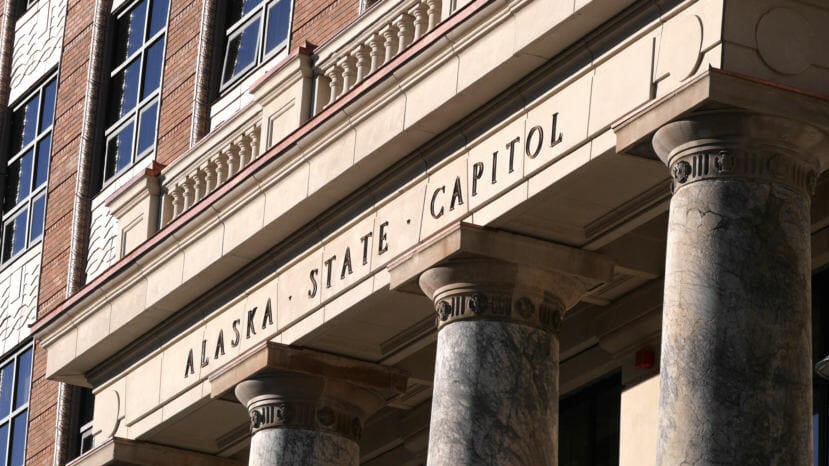
The Alaska Legislature passed a budget over the weekend with roughly $5.4 billion in state spending. It includes funding for $1,000 permanent fund dividends, but no stimulus payments.
The highly charged budget debate went late on Saturday night and continued into the early hours Sunday morning.
The budget that starts in July wouldn’t cut spending on state programs.
Gov. Mike Dunleavy didn’t propose cuts this year after proposing hundreds of millions in cuts last year that prompted a popular backlash and a recall campaign.
What he proposed for state services was close to what ended up passing through both chambers of the legislature.
The budget, House Bill 205, doesn’t include a state-sponsored stimulus payment, which Dunleavy sought and the Senate passed in its version of the budget. It didn’t make it through the conference committee process with the House.
Anchorage Democratic Sen. Elvi Gray-Jackson said she supported the stimulus payment. But she noted that federal stimulus payments are coming.
“Under normal circumstances, we would have struggled to make sure that the budget appropriated funds in a way that more closely reflected the concerns and values of our constituents,” Gray-Jackson said. “But we did the best we could with the resources and the time frame we have.”
The bill doesn’t include a full, roughly $3,100 permanent fund dividend under the formula set in state law, but it does include $1,000 PFD payments — to be made in October.
The budget would draw $3.1 billion from the Permanent Fund’s earning reserve. And it would draw an additional $1.1 billion from the state’s main savings account, the Constitutional Budget Reserve — mostly because of the recent collapse in oil prices. That means the state’s savings will be near the minimum it needs to pay the bills.
The state enacted a law two years ago that limits the draw from the permanent fund’s earnings to roughly 5 percent or less of the fund’s total value. And the draw in this budget would be within that limit.
Nome Democratic Representative Neal Foster said that’s responsible.
“Taking too much now means that we’d be taking and eroding from what future generations should also enjoy,” he said. “The math is the math. We can continue to push the hard decisions on to future legislatures. But we were sent here to … make those hard decisions.”
The budget includes $80 million in funding for COVID-19 response. The Legislature passed a separate measure, House Bill 241, that would provide relief from the outbreak, extend the governor’s disaster emergency declaration to November and provide moratoriums on evictions and foreclosures for those facing hardship from the disaster.
Lawmakers said they expect to pass more disaster response bills whenever they reconvene.
The draw from the state’s savings comes with a provision that required three-quarters of both chambers to agree to use some of the money for disaster relief and half of the dividend.
Wasilla Republican Sen. Mike Shower voted no and was outraged by the idea of it.
“I see how the game’s played,” he said. “Do as you’re told or we’re going to hit you over the head. We’re going to make you the bad guy. Tied COVID funding for this; all this stuff tied together. If I don’t vote for this budget, if I don’t vote for the CBR, that somehow I’m the bad guy. I want people to die. I’m not supporting COVID-19 because I don’t vote for this budget. Or it’s my fault people get a smaller PFD. Ridiculous.”
Wasilla Republican Rep. Cathy Tilton voted for it, reluctantly. She noted the disaster funding could save lives, but said it shouldn’t have been tied to the vote.
“Right now, I am put in a position where my vote risks and gambles the lives of Alaskans,” she said.
Budget supporters said it was responsible to maintain state services. While similar to what Dunleavy proposed, the spending plan includes more money for public education, the University of Alaska, the ferry system, school bond debt reimbursement and rural school construction.
The budget also includes a plan to transfer $1.06 billion from the permanent fund earnings reserve to the constitutionally protected principal, to account for inflation over the past year.
It would fully fund a bill passed last week that covers unbudgeted state expenses through June, including more disaster response and hospital Medicaid payments.
And it would maintain state accounts that fund programs that include equalizing the power costs in higher-cost areas with those in lower-power-cost areas and paying for university scholarships.
Once legislative leaders send the budget bill to Dunleavy, he’ll have 15 days, excluding Sundays, to sign it.
The weekend may prove to be the end of the legislative session, though lawmakers recessed instead of adjourning. This leaves the door open to them reconvening before the session must end, on May 20.
The Senate voted 13-4 to pass the budget, with Democratic senators Scott Kawasaki of Fairbanks; Donny Olson of Golovin; and Bill Wielechowski of Anchorage joining Shower in voting no. Shower was the only senator to vote against the CBR draw. Republican Senators Mia Costello of Anchorage; Shelley Hughes of Palmer; and Lora Reinbold of Eagle River were absent.
In the House, the budget passed, 23-13, along caucus lines, with caucusless Republicans David Eastman of Wasilla and Gabrielle LeDoux of Anchorage joining the minority in voting no.
The House passed the CBR draw with the minimum number of votes needed — 30 in favor and six opposed. The six representatives to vote against the CBR draw were Republicans Ben Carpenter of Nikiski; Sharon Jackson of Eagle River; Laddie Shaw of Anchorage; Sarah Vance of Homer; Eastman; and LeDoux. Republican Representatives Kelly Merrick of Eagle River, Mark Neuman of Big Lake, Sara Rasmussen of Anchorage and George Rauscher of Sutton were absent.
